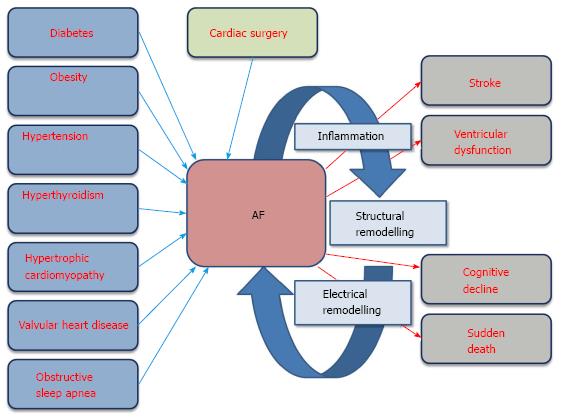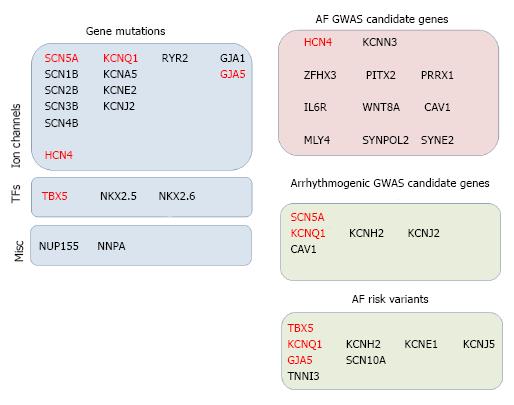Copyright
©The Author(s) 2016.
World J Med Genet. Feb 27, 2016; 6(1): 1-16
Published online Feb 27, 2016. doi: 10.5496/wjmg.v6.i1.1
Published online Feb 27, 2016. doi: 10.5496/wjmg.v6.i1.1
Figure 1 Schematic representation of the clinically relevant risk factors influencing the onset of atrial fibrillation.
Atrial fibrillation (AF) leads thereafter to distinct cellular and molecular remodeling events, including structural and electrical remodeling, in part as caused by inflammatory process. In addition, progression of AF is highly associated with the onset of additional cardiac pathophysiologies.
Figure 2 Schematic representation genes associated to atrial fibrillation.
On the one hand, gene mutations associated to atrial fibrillation (AF) are illustrated. On the other hand, genes associated to AF by means of GWAS are also illustrated. In the latter, three subset of genes are provided: (1) those directly linked to AF GWAS analyses; (2) those related to AF, but identified in arrhythomogenic syndromes GWAS analyses; and (3) risk variants association studies in small AF cohorts by a candidate approach strategy. Genes highlighted in bold represent those genes identified in AF by multiple approaches. GWAS: Genome-wide association analyses.
Figure 3 Schematic representation of the Pitx2 downstream pathways involved in pro-arrhythogenic events leading to atrial fibrillation.
Multiple lines of evidences demonstrate that PITX2 exerts a pivotal role regulating expression of distinct ion channels, cell-cell coupling, blood pressure controlers and beta-adrenergic stimulation. Most of these pathways are modulated by microRNAs which are under control of PITX2 action. Red denotes down-regulation and green upregulation.
- Citation: Franco D, Lozano-Velasco E, Aranega A. Gene regulatory networks in atrial fibrillation. World J Med Genet 2016; 6(1): 1-16
- URL: https://www.wjgnet.com/2220-3184/full/v6/i1/1.htm
- DOI: https://dx.doi.org/10.5496/wjmg.v6.i1.1











